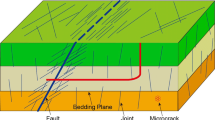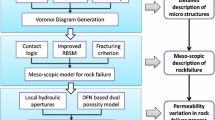Abstract
A fast upscaling procedure for determining the equivalent hydraulic conductivity of a three-dimensional fractured rock is presented in this paper. A modified semi-analytical superposition method is developed to take into account, at the same time, the hydraulic conductivity of the porous matrix (KM) and the fractures (KF). The connectivity of the conductive fracture network is also taken into account. The upscaling approach has been validated by comparison with the hydraulic conductivity of synthetic samples calculated with full numerical procedures (flow simulations and averaging). The extended superposition approach is in good agreement with numerical results for infinite size fractures. For finite size fractures, an improved model that takes into account the connectivity of the fracture network through multiplicative connectivity indexes determined empirically is proposed. This improved model is also in good agreement with the numerical results obtained for different configurations of fracture networks.






















Similar content being viewed by others
Notes
The terms “narrow bounds” and “tight bounds” both refer to the case where the lower and upper bounds (KLOW and KUP) are relatively close to each other; obviously, the inequality becomes an equality in the ideal case of equal bounds (KLOW = KUP).
Homogeneity, ergodicity, isotropy. A random field, such as K(x) or lnK(x), is a random function of position (x). The moments of a statistically homogeneous, or “stationary”, random field are invariant by translation. Ergodicity refers to the convergence of spatial averages (spatial moments) to ensemble averages (ensemble moments), in the limit of infinite spatial domain. In practice, only the 1st and 2nd order moments are considered (2nd order stationarity and ergodicity). Finally, statistical isotropy refers to the case where the moments of the random field are invariant by rotation.
Probability distribution of a random field F(x). One should distinguish the single-point probability law of F(x), from its general multipoint probability law. In the case of a Gaussian random field, the one-point and two-point moments suffice to entirely define its multipoint probability law. In the two-dimensional case at hand, if F = lnK(x,y) is assumed Gaussian (in the sense “multi-Gaussian”), then K(x,y) is by definition a “log-normal” random field. In that case, it can be shown that K/KG and its inverse KG/K both have well defined multipoint laws (log-normal) with the same moments. Furthermore, the mean, variance and two-point covariance of the log-normal K(x,y) can be explicitly related to those of the Gaussian lnK(x,y).
Infinite size fractures. It is understood in this paper that the term “infinite size fracture” or “infinite fracture” refers to any planar fracture that entirely crosses the upscaling domain. More precisely, if the upscaling domain is a convex region of finite volume (e.g., a three-dimensional parallelepiped), then an “infinite fracture” is a planar object that completely crosses the domain: it separates the domain in two subdomains, and its trace on the domain boundary is a closed curve. If the upscaling domain is infinite, then an “infinite fracture” is simply a planar fracture of infinite diameter.
The consequence in three-dimensional space is that the longitude angle Ө must be distributed uniformly in [0, 2π], and (independently) the latitude angle φ has its cosine distributed uniformly in [− 1, + 1].
A “finite size” fracture is any planar fracture which does not entirely cross the upscaling domain: the opposite of “infinite sire” fracture mentioned in Sect. 2.
The planar disc fractures studied in this work are a special limit form of planar convex polygons as the number of edges goes to infinity.
References
Ababou R (1990) Identification of effective conductivity tensor in randomly heterogeneous and stratified aquifers. In: Bachu S (ed) Proceedings Fifth Canadian–American conference on hydrogeology: parameter identification and estimation for aquifers and reservoirs, Calgary, Alberta, Canada, Sep. 18–20, 1990. Nat. Water Well Assoc., Water Well Journal Publish. Co., Dublin, Ohio, 1990, pp 155-157
Ababou R, Bagtzoglou AC(1993) BIGFLOW: a numerical code for simulating flow in variably saturated, heterogeneous geologic media (theory & user’s manual, Version 1.1). Report NUREG/CR-6028, U.S. Nuclear Regul. Commission, Gov. Printing Office, Washington, DC
Ababou R., Renard P (2011) Equivalent permeability tensor in fractured media: an algebraic approach. In: Amaziane B, Barrera D, Mraoui H, Rodriguez ML, Sbibih D (eds) Proceedings MAMERN11: 4th internat. conf. on approx. methods and numer. model. in envir. and natur. resour. (Saïdia, Morocco, May 23–26, 2011). Univ. Granada (2011), ISBN: 078-84-338-5230-4, 2011
Ababou R, McLaughlin D, Gelhar LW, Tompson AF (1989) Numerical simulation of three-dimensional saturated flow in randomly heterogeneous porous media. Transp Porous Media 4(6):549–565
Ababou R, Millard A, Treille E, Durin M, Plas F (1994) Continuum modeling of coupled thermo-hydro-mechanical processes in fractured rock. In: Peters XA et al (eds) Computational methods in water resources. Kluwer Academic Publishers, Netherlands, pp 651–658
Ababou R, Cañamón Valera I, Poutrel A (2011) Macro-permeability distribution and anisotropy in a 3D Fissured and fractured clay rock: ‘Excavation Damaged Zone’ around a cylindrical drift in Callovo-Oxfordian Argilite (Bure). J Phys Chem Earth (Spec. Issue “Clays in Natural & Engineer. Barriers for Radioact. Waste Confin.”: CLAYS 2010, Nantes, 29 March–1st April 2010). 36(17–18):1932–1948. ISSN 1474-7065. https://doi.org/10.1016/j.pce.2011.07.032
Adler PM, Thovert J-F (1999) Fractures and fracture networks. Kluwer Academic Publishers, Dordrecht
Adler PM, Thovert J-F, Mourzenko VV (2012) Fractured porous media. Oxford University Press, Oxford
Balberg I, Anderson CH, Alexander S, Wagner N (1984) Excluded volume and its relation to the onset of percolation. Phys Rev B 30:3933
Bamberger A (1977) Approximation des coefficients d’opérateurs elliptiques, stables pour la G-convergence. Rapport du Centre de mathématiques appliquées, École polytechnique, n° MAP/15
Berkowitz B, Adler PM (1998) Stereological analysis of fracture network structure in geological formations. J Geophys Res [Solid Earth] 103:15339–15360
Bouwer H (1969) Planning and interpreting soil permeability measurements. J Irrig Drain Div, ASCE 95:391–402
Brown SR (1987) Fluid flow through rock joints: the effect of surface roughness. J Geophys Res 92(B2):1337–1347. https://doi.org/10.1029/JB092iB02p01337
Budiansky B (1965) On the elastic moduli of some heterogeneous materials. J Mech Phys Solids 13:223
Cañamón I (2006) Analysis and modeling of coupled thermo-hydro-mechanical phenomena in three-dimensional fractured media. PhD thesis, Institut National Polytech. de Toulouse & Univ. Politécnica de Madrid
Cardwell WT, Parsons RL (1945) Average permeabilities of heterogeneous oil sands. Trans Am Inst Mining Metall Pet Eng 160:34–42
Charlaix E, Guyon E, Rivier N (1984) A criterion for percolation threshold in a random array of plates. Solid State Commun 50(11):999–1002
Dagan G (1979) Models of groundwater flow in statistically heterogeneous porous formations. Water Resour Res 15(1):47–63
Desbarats AJ (1992) Spatial averaging of hydraulic conductivity in three-dimensional heterogeneous porous media. Math Geol 24(3):249–267
Deutsch C (1989) Calculating effective absolute permeability in sandstone/shale sequences. SPE Form Eval 4:343–348
Dimitrakopoulos R, Desbarats AJ (1997) Geostatistical modelling of grid block permeabilities for 3D reservoir simulators. SPE Reservoir Eng 8:13–18
Farmer CL (2002) Upscaling: a review. Int J Numer Meth Fluids 40:63–78
Hashin Z, Shtrikman S (1963) A variational approach to the theory of elastic behaviour of multiphase materials. J Mech Phys Solid 11:127–140. https://doi.org/10.1016/0022-5096(63)90060-7
Journel AG, Deutsch, C, Debarats AJ (1986) Power averaging for block effective permeability: SPE 15128, presented at the 56th California Regeonal Meeting of the SPE, Oakland, California, April 2–4, 1986
Kfoury M, Ababou R, Noetinger B, Quintard M (2006) Upscaling fractured heterogeneous media: permeability and mass exchange coefficient. J Appl Mech (JAM), Trans ASME 73(1):41–46
Kiraly L (1969) Anisotropie et hétérogénéité de la perméabilité dans les calcaires fissurés. Eclogae Geol Helv 62(2):613–619
Lang PS, Paluszny A, Zimmerman RW (2014) Permeability tensor of three-dimensional fractured porous rock and a comparison to trace map predictions. J Geophys Res Solid Earth 119:6288–6307. https://doi.org/10.1002/2014JB011027
Le Loc’h, G (1988) An efficient strategy for combining the permeabilities: practical application on a simulated reservoir. In: Proc. of the 3rd internat. Geostatistics congress, Avignon, Sept 5–9
Li L, Zhou H, Gómez-Hernández JJ (2011) A comparative study of three dimensional hydraulic conductivity upscaling at the macro-dispersion experiment (MADE) site, Columbus Air Force Base, Mississippi (USA). J Hydrol 404:278–293. https://doi.org/10.1016/j.jhydrol.2011.05.001
Long JCS, Remer JS, Wilson CR, Witherspoon PA (1982) Porous media equivalents for networks of discontinuous fractures. Water Resour Res 18(3):645–658
Marchant.J (1977) Sur la résistance équivalente d’un réseau aléatoire de structure irrégulière. CR Acad Sci Paris, t.284, Série B-85:88
Matheron G (1967) Eléments pour une Théorie des Milieux Poreux. Masson et Cie, Paris, p 166
Mourzenko VV, Thovert JF, Adler PM (2005) Percolation of three-dimensional fracture networks with power-law size distribution. Phys Rev E 72:036103
Mourzenko V, Thovert J-F, Adler PM (2009) Proceedings of the international conference on rock joints and jointed rock masses, Tucson, Arizona
Oda M (1985) Permeability tensor for discontinuous rock masses. Géotechnique 35(4):483–495. https://doi.org/10.1680/geot.1985.35.4.483
Oda M (1986) An equivalent continuum model for coupled stress and fluid flow analysis in jointed rock masses. Water Resour Res 22(13):1845–1856
Pouya A, Fouché O (2009) Permeability of 3D discontinuity networks: new tensors from boundary-conditioned homogenization. Adv Water Resour 32:303–314
Pozdniakov S, Tsang C-F (2004) A self-consistent approach for calculating the effective hydraulic conductivity of a binary, heterogeneous medium. Water Resour Res 40:W05105. https://doi.org/10.1029/2003WR002617
Renard P, de Marsily G (1997) Calculating equivalent permeability: A review. Adv Water Resour 20:253–278
Renard P, Ababou R (2009) Relation between the definition and properties of the equivalent permeability tensor in heterogeneous and fractured porous media. In: Amaziane B et al (eds) Proceedings MAMERN 09: 3rd international conference on approximation methods and numerical modeling in environment and natural resources (Pau, France, 8–11 June 2009), Editorial Univ. de Granada, ISBN: 978-84-338-5006-5
Renard Ph, Le Loc’h G, Ledoux E, de Marsily G, Mackay R (2000) A fast algorithm for the estimation of the equivalent hydraulic conductivity of heterogeneous porous media. Water Resour Res 36(12):3567–3580
Sævik PN, Berre I, Jakobsen M, Lien M (2013) A 3D computational study of effective medium methods applied to fractured media. Transp Porous Media 100(1):115–142
Sahimi M (1995) Flow and transport in porous media and fractured rock. VCH, New York
Snow DT (1969) Anisotropic permeability of fractured media. Water Resour Res 5(6):1273–1289
Tsang YW (1984) The effect of tortuosity on fluid flow through a single fracture. Water Resour Res 20:1209–1215
Vanmarcke E (1983) Random fields (analysis and synthesis). The MIT Press, Cambridge
Warren JE, Price HS (1961) Flow in heterogeneous porous media. Soc Pet Eng J 1:153–169
Wen XH, Gomez-Hernandez JJ (1996) Upscaling hydraulic conductivities in heterogeneous media: an overview. J Hydrol 183:ix–xxxii
Wiener O (1912) Abh. Math.-Phys. Klasse Königlich Sächsischen Des Wiss. Leipzig 32:509–604
Zinn B, Harvey CF (2003) When good statistical models of aquifer heterogeneity go bad: a comparison of flow, dispersion, and mass transfer in connected and multivariate Gaussian hydraulic conductivity fields. Water Resour Res 39(3):1051. https://doi.org/10.1029/2001WR001146
Acknowledgements
The first three authors wish to acknowledge the financial support of ADEME (France) in the framework of the GeotRef project “Géothermie haute énergie en Reservoirs fracturés” (www.geotref.org). We thank the anonymous reviewers for their careful reading of the manuscript and for their insightful comments and suggestions.
Author information
Authors and Affiliations
Corresponding author
Rights and permissions
About this article
Cite this article
Rajeh, T., Ababou, R., Marcoux, M. et al. Fast Upscaling of the Hydraulic Conductivity of Three-Dimensional Fractured Porous Rock for Reservoir Modeling. Math Geosci 51, 1037–1074 (2019). https://doi.org/10.1007/s11004-019-09785-w
Received:
Accepted:
Published:
Issue Date:
DOI: https://doi.org/10.1007/s11004-019-09785-w




